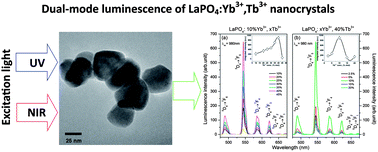The effects of down- and up-conversion on dual-mode green luminescence from Yb3+- and Tb3+-doped LaPO4 nanocrystals†
Abstract
Monoclinic LaPO4

* Corresponding authors
a
Adam Mickiewicz University, Faculty of Chemistry, Department of Rare Earths, Grunwaldzka 6, 60-780 Poznań, Poland
E-mail:
tgrzyb@amu.edu.pl
Fax: +48 618291505
Tel: +48 618291346
b Institute of Low Temperature and Structure Research, Polish Academy of Sciences, Okólna 2, 50-442 Wrocław, Poland
Monoclinic LaPO4

 Please wait while we load your content...
Something went wrong. Try again?
Please wait while we load your content...
Something went wrong. Try again?
T. Grzyb, A. Gruszeczka, R. J. Wiglusz and S. Lis, J. Mater. Chem. C, 2013, 1, 5410 DOI: 10.1039/C3TC31100G
To request permission to reproduce material from this article, please go to the Copyright Clearance Center request page.
If you are an author contributing to an RSC publication, you do not need to request permission provided correct acknowledgement is given.
If you are the author of this article, you do not need to request permission to reproduce figures and diagrams provided correct acknowledgement is given. If you want to reproduce the whole article in a third-party publication (excluding your thesis/dissertation for which permission is not required) please go to the Copyright Clearance Center request page.
Read more about how to correctly acknowledge RSC content.
 Fetching data from CrossRef.
Fetching data from CrossRef.
This may take some time to load.
Loading related content
